
BINGHAMTON, NEW YORK—Michael Jacobson of Binghamton University wants to know if there are any archaeological traces of the Battle of Chemung, part of a strategically important offensive that took place in 1779 during the Revolutionary War. The Sullivan-Clinton Expedition of the Continental Army first attacked the village of New Chemung, a base for British loyalists and their Native American allies, and burned it to the ground. Two weeks later, General Sullivan’s troops defeated the British loyalists and the Iroquois at the nearby Battle of Newtown. With the help of historic documents and the official map from the Sullivan expedition, a recent topographical map, and a geographic information system, Jacobson and his team were able to examine the cornfield where they think the Battle of Chemung took place with a magnetometer. Tests should reveal if their finds date to the late eighteenth century. “There was a local push to highlight the fact that Chemung was a separate battle from Newtown, and also to help preserve the landscape,” Jacobson explained.









